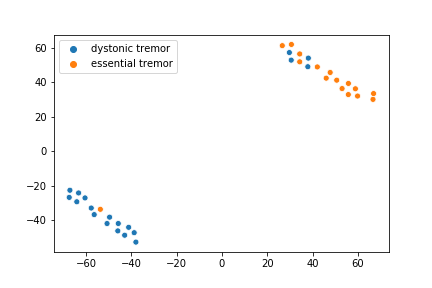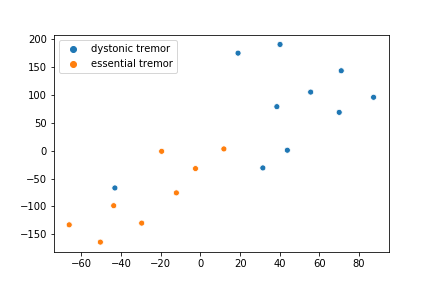Objective: Identify differences between ET and DT using video-based time series analysis of the fingertip.
Background: Tremor types are classified based on clinical features and additional symptoms according to respective diagnostic criteria [1,2]. The criteria of ET versus DT are subject of vivid discussions and regular change. Current criteria stress the importance of the absence of other neurological signs for the diagnosis of ET whereas DT and tremor associated with dystonia require the presence of dystonia, yet no characteristics of the tremor itself allow their differentiation.
Method: Annotated videos were collected from online available scientific publications on ET (5) and DT (7) [3-14]. These were cut into shorter scenes when tasks or patients changed resulting in 29 scenes for DT and 24 for ET. The position of a fingertip (Dig I, II or III) was tracked using a deep-learning tracking framework [15]. The resulting time series was tested using a feature analysis tool [16] to extract characteristic features. Relevant features regarding the tremor type were identified [17] with a false discovery rate set to 0.25. The data set was divided into publications before 2018 (3 for ET, 5 for DT) and after 2018 (2 for ET & DT each). Analysis was performed on the whole data set and each subset separately.
Results: For the whole data set no feature significantly distinguished the two tremor types. Analysis of the data published before 2018 showed partial autocorrelation in horizontal direction at a lag of two to be significant (p < .001). Visualization using t-distributed stochastic neighborhood embedding (t-SNE) [18] reveals a possible separation of the two tremor types based on this feature [figure1].
Analysis of the data published after 2018 revealed no individual feature distinguishing the tremor types on a significant level. However, by selecting the two features with the smallest p-value (p < .002), and visualizing using t-SNE a tendency of separation between the tremor types can be seen [figure2].
Conclusion: The clinical differentiation of ET and DT based on current consensus follows syndromal criteria irrespective of tremor characteristics per se. The embedding of the data gives a hint that the two types of tremor can be distinguished based on computed differences of tracked fingertip-movement only. Interestingly the distinguishing tremor characteristics changed following the updated consensus statement [2].
References: [1] Deuschl, G., et al. Consensus Statement of the Movement Disorder Society on Tremor. Movement Disorders, 13 (1998). [2] Bhatia, K. P., et al. Consensus Statement on the classification of tremors. From the task force on tremor of the International Parkinson and Movement Disorder Society. Movement disorders 33.1 (2018): 75–87. [3] Ganos, Christos, et al. “Dystonic tremor and spasmodic dysphonia in spinocerebellar ataxia type 12.” Movement disorders clinical practice 1.1 (2014): 79-81. [4] Cáceres‐Redondo, María T., et al. “DYT‐1 gene dystonic tremor presenting as a “scan without evidence of dopaminergic deficit”.” Movement Disorders 27.11 (2012): 1469-1469. [5] Yoon, Won Tae, et al. “Novel PANK2 gene mutations in Korean patient with pantothenate kinase‐associated neurodegeneration presenting unilateral dystonic tremor.” Movement disorders 25.2 (2010): 245-247. [6] Pandey, Sanjay, and Neelav Sarma. “Tremor in Dystonia: A Cross‐sectional Study from India.” Movement Disorders Clinical Practice 4.6 (2017): 858-863. [7] Magrinelli, Francesca, et al. “Twelve‐year Follow‐up of A Large Italian Family with Atypical Phenotypes of DYT1‐dystonia.” Movement disorders clinical practice 6.2 (2019): 166-170. [8] Gövert, Felix, et al. “Temporal discrimination is altered in patients with isolated asymmetric and jerky upper limb tremor.” Movement Disorders 35.2 (2020): 306-315. [9] Schneider, Susanne A., et al. “Patients with adult‐onset dystonic tremor resembling parkinsonian tremor have scans without evidence of dopaminergic deficit (SWEDDs).” Movement disorders 22.15 (2007): 2210-2215. [10] Dupuis, Michel J‐M., et al. “Disappearance of essential tremor after stroke.” Movement disorders 25.16 (2010): 2884-2887. [11] Kim, Joong‐Seok, et al. “Disappearance of essential tremor after frontal cortical infarct.” Movement disorders 21.8 (2006): 1284-1285. [12] DiLorenzo, Daniel J., et al. “Long‐term deep brain stimulation for essential tremor: 12‐year clinicopathologic follow‐up.” Movement disorders 25.2 (2010): 232-238. [13] Hale, Evan A., and Elan D. Louis. “Severe Essential Tremor: Illustrative Videos.” Tremor and Other Hyperkinetic Movements (2019). [14] Gövert, Felix, et al. “Temporal discrimination is altered in patients with isolated asymmetric and jerky upper limb tremor.” Movement Disorders 35.2 (2020): 306-315. [15] Mathis, Alexander, et al. “DeepLabCut: markerless pose estimation of user-defined body parts with deep learning.” Nature neuroscience 21.9 (2018): 1281. [16] Christ, Maximilian, et al. “Time series feature extraction on basis of scalable hypothesis tests (tsfresh–a python package).” Neurocomputing 307 (2018): 72-77. [17] Benjamini, Yoav, and Daniel Yekutieli. “The control of the false discovery rate in multiple testing under dependency.” Annals of statistics (2001): 1165-1188. [18] Maaten, Laurens van der, and Geoffrey Hinton. “Visualizing data using t-SNE.” Journal of machine learning research 9.Nov (2008): 2579-2605.
To cite this abstract in AMA style:
R. Stark, P. Fischer. Discriminating Essential and Dystonic Tremor using Video-based Time Series Analysis [abstract]. Mov Disord. 2020; 35 (suppl 1). https://www.mdsabstracts.org/abstract/discriminating-essential-and-dystonic-tremor-using-video-based-time-series-analysis/. Accessed December 17, 2025.« Back to MDS Virtual Congress 2020
MDS Abstracts - https://www.mdsabstracts.org/abstract/discriminating-essential-and-dystonic-tremor-using-video-based-time-series-analysis/


